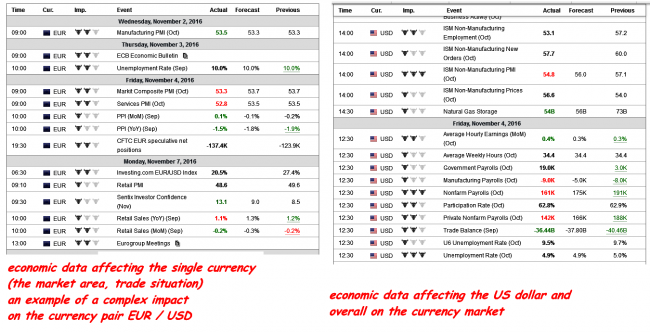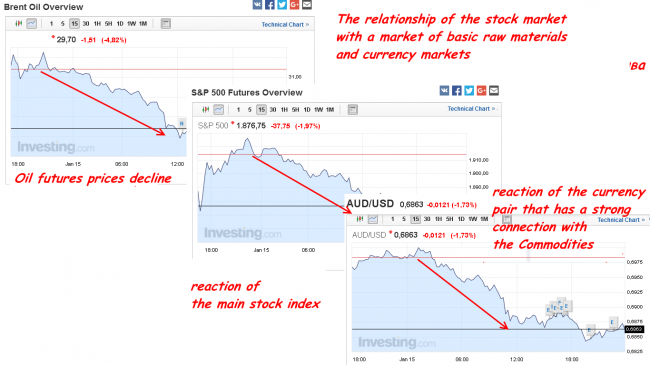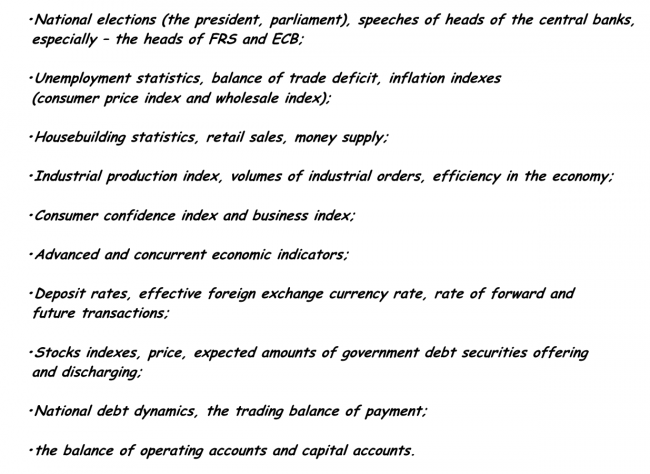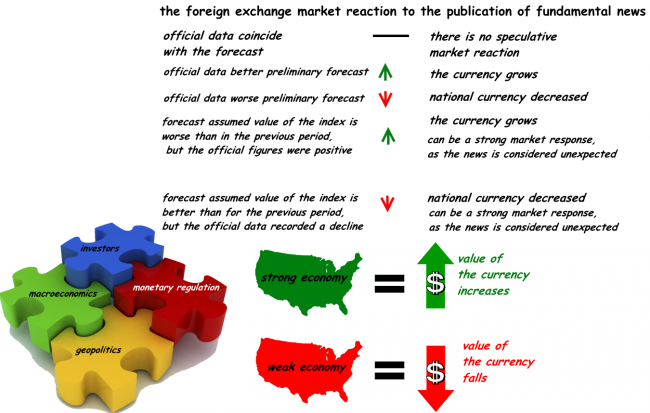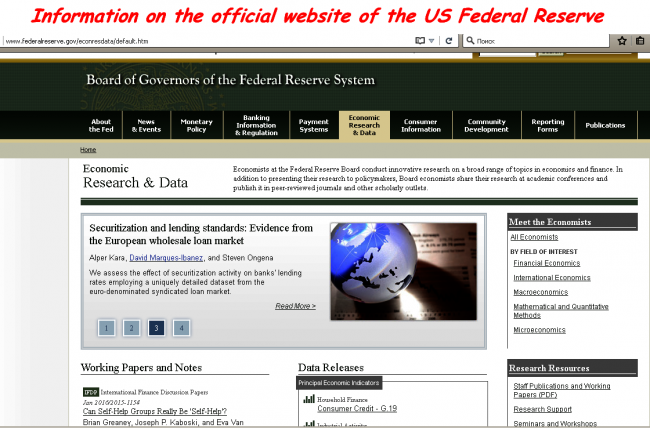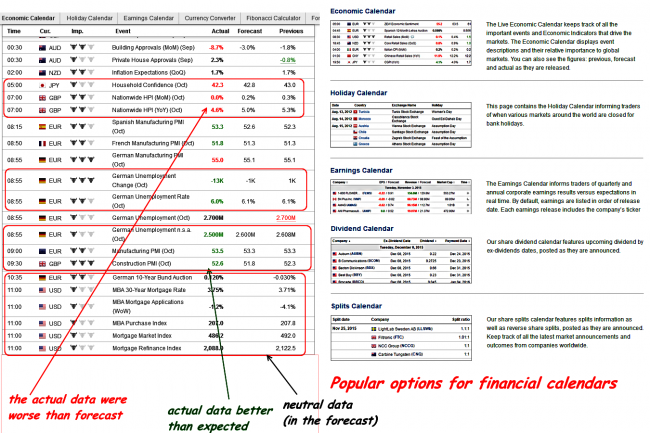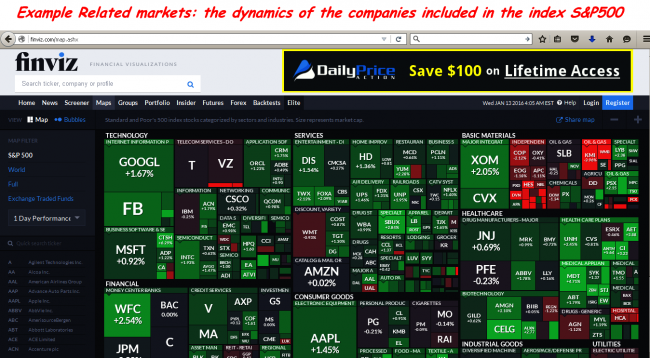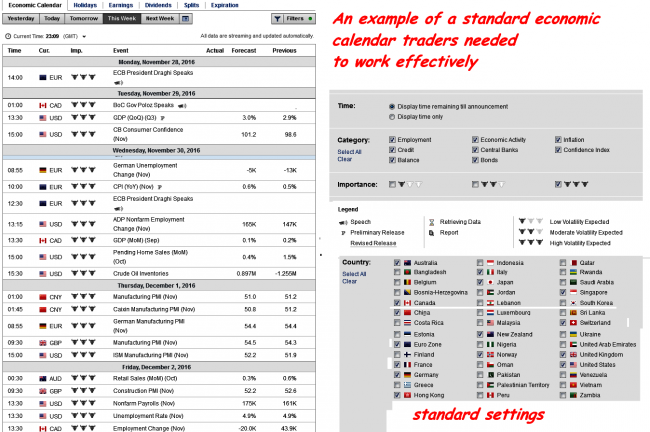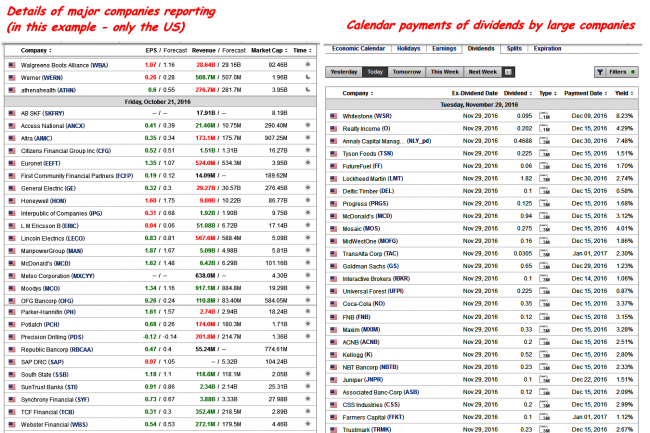The debates on what governs the market – technique or base, probably, are timeless. Nevertheless, today fundamental analysis is a necessary element of confident trading on any asset, and underestimation of its influence may cause serious losses. Let`s consider its main factors and technique of application.
Today many fundamental factors actively influence the currency rates, generating demand/offer on a certain asset. For instance, if demand for American export grows, then demand the dollar in importing countries rises, that finally strengthens the dollar to other currencies. But any uncertainty or instability, including political, leads to the fact the investors dispose of the same dollar, escaping to more secured assets, and its rate begins to decline.
At the same time, far from all factors or events may seriously influence the market movement. Those, which easily are estimated or fit into the standard expectations, can`t arouse speculative fluctuations or break the current situation yet, as market accounted its influence in current price yet. In case of searching of optimal solution you can`t do without use of fundamental analysis – a set of techniques of analysis of financial, economic, political, technical and natural factors, which influence all types of financial assets, the certain countries and regions, industries, companies, and as a result – the world economy in general.
The history of the term «fundamental analysis» begins from the financial school of the American scientists Benjamin Graham and David Dodd, rather from the publication in far 1934 of their classical writing «Security analysis». This interesting, but a complicated book about conservative views to investment with a lot of examples from the economic history of the USA of the first half of 20th century, is actual also for modern market conditions. Authors successfully applied created techniques into practice and were in the top decile of the most successful investors. Warren Buffett became the most famous of their follower, till now works in the market only on the basis of fundamental estimations. From the point of view of the technique, this type of analysis researches the influence of macroeconomic and geopolitical factors, and also any monetary actions of central banks on the rate of the financial asset. Furthermore, the complex estimation of indicators is significant, therefore no single information can be the basis for making a trading decision.
Purposes of the fundamental analysis
The main – estimation and take profit from future price movement, detection and estimation of events, which may influence it. The main result of the analysis is the detection of current (and future) fair price (cost) of chosen asset (or set of assets) and construction approximate dynamics of its achievement.
If current price deviates from fair (from the point of view of basis) market price, then the trading asset is considered as overestimated (overbought) or underestimated (undersold) – it means the market shall move towards of achievement of predicted level.
The large players work in such way continuously creating the market disbalance by speculative amounts and compelling the mass of small players to move in the certain direction.
There are two types of FA:
- Long-term: when the certain «set» of fundamental factors will estimate the condition of global or separate national economy for the period from 3-6 months to a few years. The result of such long-term estimation is used for strategic positions.
- Short-term: the influence of fundamental information on the market within some hours (minutes).
Elements of FA are usually estimated from the point of view of influence on the general condition of national economy or influence on an official refinancing rate.
It is important to remember that any fundamental information – is always respective. The process of fundamental analysis moves from global macroeconomic data to the analysis of certain regions, countries, industries, the minimal level of analysis – certain companies (assets, stocks), that is itemized from complicated elements to simpler.
The next levels are the base for the fundamental analysis:
- Of the national economy: the complex analysis of data of political and economic condition of the county, estimation of raw material and financial
- Of the industries: studying of demand/offer, prices, technology and parameters of production for the estimation of development;
- Of the company (financial asset, index, security): assessment of financial reports, management system, business strategies, competitive environment.
Everyone chose the scheme of fundamental analysis, but by classic the analytics shall move in such way:
- Analysis of the world markets, availability of force majeure and crisis events, political and economic situation in leading countries;
- Estimation of indicators and general steadiness of the country (countries, industries), which asset is analyzing;
- Influence of world and national economic indicators on middle-term and short-term dynamics of chosen asset.
The base techniques of the fundamental analysis
To detect the regularities in dynamics of the currency rates and to estimate the influence of listed fundamental factors, some standard techniques are applied.
The comparison technique
The key and especially strongly affected economic dynamic indicators are allocated from the general mass of the macroeconomic indicators, and their values are compared with different regions, certain countries, assets, time periods. It`s possible to project a general tendency of the currency rate, the price of raw material, energy supply, to calculate expected economic showings both for a certain country and for the region or an industry on an estimation of dynamics of universal indicators such as GDP or industrial production.
Example: complex influence of the statistic of leading EU countries on the Euro exchange rate.
The induction and deduction technique
Induction – is a generalization of a lot of various factors for achieving a general result. For the financial market, it means the analysis a lot of various data for estimation of the currencies dynamics. It applies as a trade factor on the current trend.
Example: impact estimation of complex statistic, for instance, Beige Bookor statistic reports of the companies.
Deduction – searching and estimation of the cause-and-effect link between events by the technique of comparison of historical data. For the market, it means the search of the factors which were not be worked yet by the market, and the estimation of possibility of reverse or weakening of the current trend.
Example: the analysis of the mutual influence of raw and stock market on the currency pair dynamics.
The correlation technique
The estimation of the future dynamics of several assets on the basis of direct or reverse interconnection, and also dependence on other assets.There are many technical indicators for this purpose today.
Example: dependence of Australian dollar on the price of gold or currency pair USD/CAD on an oil price. It is possible to draw a conclusion on buy/sell the US dollar watching the price of raw assets.
The grouping terms and generalization method
The option of correlation analysis: currency, raw or other assets are groupings in separate blocks, which are the base for calculation of index showings. The dynamics of this index is prevailing for all components.
Example: calculation of the generalized index of currencies of developing countries influencing a general trend, and it isn`t recommended to trade against it by any certain currency from the calculated group. One more classical example – S&P500 index dynamics.
The season technique
The influence of weather and calendar factors on economic trends. The particular case is speculative fluctuations of the trading amounts within the periods of opening/closing of key trading sessions.
Example: the weather conditions affecting agriculture, the employment of seasonal workers, an increase of the consumer spendings at holidays, currency purchasing for the tax payments at the fiscal period.
The fundamental analysis yields stable result only in cases when analyzed country works in market economy conditions, so all external and internal factors aren`t regulated and aren`t suppressed by the government. Otherwise, as in the case of modern China, it is impossible to count their actions by any techniques and it is possible to estimate only the final result.
The main factors of fundamental analysis
Let`s list shortly the main showings of national economy affecting market condition:
- Inflation expectation and actual inflation level;
- Bank interest rates and refinancing rates;
- Growth dynamics of the stock of money in the domestic market;
- General level of credibility to the certain currency of the world financial market;
- Solvency of the certain country;
- Monetary and domestic policy of central bank;
- Internal and external emission of the national currency;
- Exchange rate interventions;
- The large investment and foreign trade contracts in national currency;
- Balance of export/import;
- Trust of people to the national currency.
The industries of national economy which are accounted in case of estimation of general tendencies:
- The market of individual wealth – showings of the economic growth: GDP (Gross Domestic Product) and GNP (Gross National Product);
- The labor market – statistics of employment, unemployment dynamics, sectors showings of workforce;
- The money market – for reflection of the situation with inflation;
- Condition and dynamics of foreign exchange market;
- The stock market – share condition, the level of liquidity and general capitalization.
Force-majeure influence
All unpredictable phenomena in nature and society impact the economy in general and in particular – on the financial market. It is necessary to estimate correctly this influence and to chose the most rational tactics of trade behavior.
The force-majeure events usually are:
- Military conflicts: the county-aggressor usually wins economically. Society, in general, is consolidated, the internal conflicts, including the implementation of the business interests, are suspended, capitalization of the economy increases because of military orders, production and employment grow, the charges for social needs are reduced.
- Natural disaster and manmade disaster: has a negative effect on the national currency rate, raw material and energy supply prices grow. The country or region traditionally are not ready to casualties, destructions, environmental disasters and social problems, that gives an excellent motive for speculations. Moreover, if information on scales of losses and death toll are exaggerated, then appeared speculative trend also quickly turns.
- Political upheavals and insurrections: any political instability has a bad impact on national currency and stocks, and also on the price of goods and raw materials supplied by the country. But if such fact is the result of long economic problems or political crisis, then such situation can't already be considered as force-majeure – the market manages to develop the common reaction which can be counted by the techniques of technical analysis.
It is important: in case of trade in a situation of force-majeure you shall make sure the transactions are fulfilled by the broker with the standard technical parameters (there are no gapping, «breakdown» of quotations, weak liquidity) and if necessary it will be possible to fix the transaction quickly.
The influence of the interest rates of the national banks on currency dynamics
The reaction on such information is quite hard predicted because it is necessary to account its two components: nominal and real change.
- Nominal change (increase): the cost of all loans grows, both originated and new, consequently it increases the cost of goods/services, which pricing this currency is pledged. It becomes not profitable for business to obtain a credit or makes payments in the national currency, the demand for it decreases and the rate falls. These phenomena are also called «comparative depreciation».
- Real increase: causes the opposite reaction: the currency become more expensive, that in the case of all other conditions being equal makes the investment of foreign money more profitable, the rate grows against the background of active demand for the national currency.
- The decrease in the rates: is an effective way of creation of the competition among national producers and additional capital raising into the country. It is performed by means of decrease interest rate of commercial banks. It gives more stability to the banks and allows to reduce the cost of loans for consumer pending on the growth of economic activity. The national currency rate is stabilized and becomes stronger.
Today the interest rates – not only economic but geopolitical factor ruling capital flows on a global scale. The correct estimation of the effect of rates change makes profitable middle-term and long-term transactions on base currency.
News in the fundamental analysis
Let`s separate groups of news influencing fundamentally on market (in order of importance):
Let`s separate fundamental indicators on US dollar:
Federal Budget Balance – the balance of government revenue and expenditure of the USA.
Beige Book FRS – the review of twelve regional departments of FRS of the USA covers the field of industrial activity, the field of services, pecuniary institutions, agriculture, the field of real estate and labor market.
Durable Goods Orders m/m – the consumer confidence index at a certain time, uses statistics on goods, which operating life exceeds three years.
Average hourly earnings m/m – the inflation potential (in the form of the absolute magnitude or an index), directly connected with labor price;
Advance GDP q/q, Prelim GDP q/q, Final GDP q/q – the indicators of quarterly GDP. The growth of this indicator leads to the growth of the dollar.
Business Inventories m/m, Wholesale Inventories m/m – in the inverse relation with the dollar rate, the growth of warehouse stocks within a long time tells about the economic stagnation.
Factory Orders m/m – statistics on both durable and nondurable goods are used for calculation of this index.
Import Prices m/m – shows the monthly change in the import goods prices. It`s important for the estimation of the inflation.
Non-Farm Employment Change – an indicator showing a change of employment level in all sectors of U.S. economy, excluding agriculture. This is so-called «market-mover», in case of growth of such index the dollar usually strengthens.
Unit Labor Costs q/q – is calculated on the basis of unit costs showing the general efficiency of the economy. The growth will be a positive factor for national currency.
Chicago PMI – is calculated upon results of questioning of managers of Chicago`s business industrial companies. If the index decreases below the level of 45-50 points, then is the mark of economy stagnation.
ISM Non-Manufacturing PMI, ISM Manufacturing PMI − is calculated upon results of questioning of managers working in the services companies and industrial companies. The growth of index tells about the possible strengthening of the dollar.
UoM Consumer Sentiment – the index is forming on the basis of questioning of consumers concerning the state of the things in the economy. The growing index shows on strengthening of the dollar.
Housing Starts – the quantity of the foundations of new houses. It changes synchronously with the FRS rate, has a tendency to season changes.
Building permits – count of the number already issued licenses for the construction of the new houses. Increasing of the index positively impact on the dollar rate.
Capacity Utilization Rate – is in the direct dependence of the dollar rate and shows the degree of use of production capacity of the USA. The level of 85% is considered as advantageous and balanced.
Personal Spending m/m, Personal Income m/m − the level of expenditures/earnings of citizens for the purposes of personal consumptions. Influence is strong, growing indicator will push the dollar rate higher.
Crude Oil Inventories – the level of the crude oil inventories in the USA.
TIC Long-Term Purchases – reflects aspiration of the non-residents to finance trading balance deficit of the USA.
Existing Home Sales – the number of houses sold in the secondary housing market. The index is distinctly higher than the similar index for the new houses.
New Home Sales – the annual quantity of the houses sold and offered for sale intended for one family. It grows at the same time as credit rate of the property-secured loans, directly connected with refinancing rate of FRS. It is characterized by season fluctuations. The growing index positively impacts on the dollar rate.
Empire State Manufacturing Index – the indicator on the basis of several indexes of the industrial sector in New York region. The index growth favorably impacts on the dollar rate.
Philly Fed Manufacturing Index – on the basis of questioning of Philadelphia`s producers concerning the state of the economy in the region. In case of its growth, the dollar strengthens.
FOMC Meeting Minutes – it contains the FOMC decision on monetary policy.
Federal Funds Rate – the main interest rate stated by FOMC for the borrowing transactions by the banks affiliated with FRS.
Unemployment Claims – weekly number of the new (primary) applications of dismissed workers for unemployment compensation. The decrease of the index usually positively impacts the national currency.
The rumors in fundamental analysis
The «rumor» in the market is considered the speculative price reaction to certain unchecked information, and also agiotage prior to the release of statistic information or economic event. Not uncommon the similar information is purposefully put in the market for creation of sharp movement, in which, of course, the large players earns. The information actively repeated, commented, analyzed, estimated, which is cause for the formation of the corresponding opinion of the most of the small participants. In such moments the price moves against any logic and common sense, a quite strong price wave appears, which can break even long-term trends.
In reality, the featured thesis «buy on rumors, sell on news» in the modern market practically doesn't work. The true information consists in rumors quickly enough deliquesces in the market (is accounted in the price), but speculations goes only on provocations and unchecked data. The experienced speculators opening positions on rumors certainly hedge the risks on other assets and in case of release of the actual information have the ability to compensate any probable losses. Only the small clients lose on the rumors.
The source of fundamental information
The main sources are:
- all kind of official statistical and economic data;
- the official and any kind of public information of governmental or financial authorities, national banks, industry organizations;
- the data of leading news and analytic agencies;
- the releases of major economic media;
- the speeches and comments of the officials, heads of financial organizations, analysts, politicians and financial experts;
- the industry reports and estimations of the development of certain sectors of the economy;
- the consolidated reportings and analytical data of major companies.
The best optimum form of presentation of fundamental information is an economic calendar, which is available on most of the websites, and also it may be integrated into the form of software informer on any resource.
There are different types of calendar, but all of them obligatory contains the list of the main statistical data, the schedule of the official necessary indicators showing the time of publication, the previous values and official estimation. News processing and primary estimation of their influence on the market occurs in real time.
And as the conclusion …
It doesn`t make a sense to debate about the importance of a fundamental understanding of the market for a long time. Technical analysis is constructed on statistical studying of the past, but the future is always determined by the politicians and economists, but certainly not mathematicians. Today the same data or events in different conditions differently impact market, and the main complexity of fundamental analysis is in such ambiguousness. The understanding of the mutual influence of assets and cross-market connections, skill «to read between lines» any information and to count influence of the absolutely different factors on the market is hard and comes only with practice. But even having a successful trading strategy you should not ignore the impact of the basis on the market. Otherwise, the market will ignore you with pleasure.
Social button for Joomla




